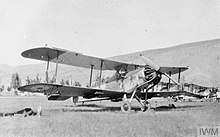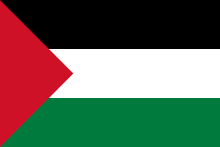Hejaz Air Force
The Hejaz Air Force (Arabic: القوات الجوية الحجازية) or Hejaz Flying Corps was the aerial component of the armed forces of the short-lived Kingdom of Hejaz and its successor the Kingdom of Hejaz and Nejd. Claiming to be the oldest air force on the Arabian Peninsular, the service was a very small entity, numbering at most nine aircraft at any time. It operated intermittently between 1921 and 1932, battling with staff shortages and aircraft availability; often only two aircraft were operational at any time. It provided aerial reconnaissance and bombardment to support the army against the much larger land forces of Ibn Saud during the Hejaz-Nejd War. Its successor is the Royal Saudi Air Force.
| Hejaz Air Force | |
|---|---|
| القوات الجوية الحجازية | |
 Westland Wapiti IIA of the type operated by the Hejaz Air Force | |
| Active | 1921–1932 |
| Country | |
| Branch | Air force |
| Role | Aerial warfare |
| Size | 2 operational aircraft, 1 pilot (1924) |
| Engagements | Battle of Mecca, Battle of Jeddah |
| Aircraft flown | |
| Bomber | Airco DH.9 |
| Reconnaissance | Westland Wapiti |
History
Foundation

On 3 January 1917, the Allied countries of France, Great Britain and Italy recognised Hussein bin Ali as the first King of the Hejaz.[1] The new monarch saw the effectiveness of air power, particularly the Palestine Brigade of the Royal Flying Corps in their support of the attack of 18 August 1918.[2] Soon after the end of the Arab Revolt, he created the Hejaz Air Force, which therefore claims to be the oldest Air Force in Arabia.[3] There were two aircraft in the new country left by the retreating Ottoman Empire, likely to be an AEG C.IV spotter and an Albatros D.III scout, but there is no record of them flying.[4]
Soon, the King ordered new aircraft from both Italy and Great Britain. The first, two Airco DH.9 and two Armstrong Whitworth F.K.8, along with four spare engines, were exported by Hugo Schumacher of Schumacher & Lavison in Cairo and arrived on 6 August 1921.[4] They were followed on 16 August by the arrival of four Le Rhône-powered Caudron general purpose aircraft and two Fiat-powered Maurice Farman trainers from Italy, license built MF.11 known as Fiat SIA.5.[5] The Caudrons had originally been going to sold to Somaliland but were redirected and sold by Tullio Pastori to bolster the new air force. There was proposed purchase of French SPAD aircraft at the same time, but none were delivered.[4]
The first flight, of a Caudron, took place at Jeddah in September 1921. Airfields at Mecca and Ta'if were prepared and the first flight to Ta'if took place in October 1921. Unfortunately, the Caudron crashed, as did the first DH.9 on the same route. These were the only operational aircraft at the time. The lack of available aircraft was a continual problem. In February 1922 the Air Force was reported to have only two aircraft in good condition, a DH.9 in Jeddah and a Caudron at Taif. In addition, one DH.9 was inoperable, one Caudron was under repair and another Caudron was termed 'useless'. The F.K.8 and SIA.5 were still unassembled. Only with the arrival of a new batch of three second-hand DH.9 aircraft, including two DH.9C cabin biplanes, in November 1924, could the force be considered operational.[4]
Personnel challenges
At the same time, King Hussein recruited personnel from around the world. On 29 July 1921 Captain Brooke, latterly of the Royal Air Force and accompanied by T. E. Lawrence, arrived, met with the King at Jeddah and started to create the infrastructure for the air force. Staff were very international. The chief mechanic, Maximov, was from Russia and the chief pilot, Leonida Schiona, from Italy. Another Russian, Nikolai Naidenov, was also a pilot. They were joined on 5 January 1922 by three more Russian pilots, another Russian mechanic, a Greek pilot and Greek mechanic. Unfortunately, Brookes had already left for Egypt, the harbinger of a persistent problem the small force had keeping pilots. The rest soon followed.[4]
Retaining staff was a constant challenge. New recruits arrived from many countries, but morale was so poor few stayed for long.[6] In fact, when a new mechanic named Klibensky arrived on 8 April 1922, he found he was the only extant member of the Air Force.[4] One solution was to train indigenous pilots. 11 April 1923 saw the first flight of Abdul Salam Sarhan, who was followed by Hassan Nazer on 3 August 1924. Both pilots fought against the advancing army of Ibn Saud.[7]
Action
Despite these challenges, the Air Force did take an active part in the defence of the realm. During the 1925 Battle of Jeddah, a lone pilot, a Russian named Shirkoff, undertook reconnaissance sorties twice daily with an Arab observer.[8] The airmen also undertook bombing missions by the simple expedient of throwing shells or grenades over the side of the aircraft. Unfortunately, these makeshift bombs were also a huge hazard, killing Shirkoff and two crew members on 18 January 1925 when their aircraft exploded and crashed while flying over an enemy camp.[9] These proved to be the only fatalities in action. However, crashes had destroyed all but one of the fleet by the end of May 1925.[4]
The arrival of six second-hand DH.9 aircraft with twelve Lewis machine guns, 120 cases of ammunition and 500 bombs on 20 August, along with an influx of German volunteers, gave the force a much needed boost but it was insufficient to stem the tide and, when Ali capitulated on 21 December 1925, the kingdom ceased to exist as an independent entity.[4]
Rebirth
When he was crowned King of Hejaz on 8 January 1926, Ibn Saud pardoned the Air Force personnel and many remained in service.[7] Although a new combined Kingdom of Hejaz and Nejd was declared a year later on 28 January 1928, the title of Hejaz Air Force continued to be used in official documents into the 1930s.[10]
Wing-Commander F W Stent was commissioned to survey the existing fleet; he found only two aircraft were serviceable and a new batch were ordered. The aircraft offered was the Westland Wapiti, a general purpose design that used many components from the DH.9.[11] Four were delivered by air from Iraq in January 1930 by British pilots accompanied by six mechanics to form the nucleus of the reborn force.[12] Unfortunately, the service's bad fortune continued. An attempt to found a new central hub on Tarout Island in 1930 was a failure, as was a new flight school at Jeddah. Once again, almost the entire staff left.[13] To boost morale, a demonstration flight was ordered on 13 September 1931. The first pilot to be asked, a Syrian, refused and was flogged. C L Lowe, the one remaining British pilot, was ill and confined to quarters but their German colleague, Kurt Krakowsky, was dragged from his sick bed by fifty troops, took off and fainted, crashing the aircraft.[14] Within a week, Lowe had also been dismissed and, for practical purposes, the service ceased to exist.[12]
Subsequent development
The successor for the Hejaz Air Force was the Royal Saudi Air Force, founded on 22 September 1932 when the Kingdom of Hejaz and Nejd was merged into the Kingdom of Saudi Arabia. The new entity took over the remaining aircraft. Flying resumed on 2 July 1934, as did accidents as one of the first pilots almost immediately taxied a Wapiti into a wall.[15]
Aircraft
| Aircraft | Origin | First delivery | Total delivered | Notes |
|---|---|---|---|---|
| Airco DH.9 | Great Britain | 6 August 1921 | 9 | |
| Airco DH.9C | Great Britain | 22 November 1924 | 2 | |
| Armstrong Whitworth F.K.8 | Great Britain | 6 August 1921 | 2 | |
| Caudron G.3 | Italy (built under license from France) | 16 August 1921 | 4 | |
| Fiat SIA 5 | Italy (built under license from France) | 16 August 1921 | 2 | |
| Westland Wapiti IIA | Great Britain | 4 January 1930 | 4 | Example preserved at Saqr Al-Jazira Aviation Museum.[16] |
The Air Force also had single AEG and Albatros aircraft left by the retreating Ottoman Empire but there is no record of these being airworthy.[4]
References
Citations
- Baker 1979, p. 115.
- Murphy 2008, p. 77.
- al-Qahtani 2017.
- Andersson 2004, p. 39.
- Taylor 1989, p. 805.
- Reader & Hodgkin 1993, p. 17.
- al-Mutawiya 2015.
- Reader & Hodgkin 1993, p. 76.
- Reader & Hodgkin 1993, p. 77.
- Tuson & Burdett 1992, p. 541.
- James 1991, p. 142.
- Andersson 2004, p. 40.
- Reader & Hodgkin 1993, p. 100.
- Gill 1931, p. 1–2.
- Reader & Hodgkin 1993, p. 101.
- "A brief about the museum". mod.gov.sa. 2017. Retrieved 25 June 2019.
Bibliography
- Andersson, Lennart (2004). "Wings Over the Desert: Aviation on the Arabian Peninsula Part One: Saudi Arabia". Air Enthusiast: 39–40.CS1 maint: ref=harv (link)
- Baker, Randall (1979). King Husain and the Kingdom of Hejaz. Cambridge: Oleander Press. ISBN 978-0-90089-148-9.CS1 maint: ref=harv (link)
- Gill, Cecil Hope (1931). P.Z.5891/35. Qatar Digital Library. Retrieved 27 June 2019.CS1 maint: ref=harv (link)
- James, Derek N. (1991). Westland Aircraft since 1915. London: Putnam. ISBN 978-0-85177-847-1.CS1 maint: ref=harv (link)
- Murphy, David (2008). The Arab Revolt 1916–18 Lawrence sets Arabia Ablaze. London: Osprey. ISBN 978-1-84603-339-1.CS1 maint: ref=harv (link)
- al-Mutawiya, Khaled (2015). "المملكة-اليوم" [Kingdom Today]. alyaum.com. Retrieved 27 June 2019.CS1 maint: ref=harv (link)
- al-Qahtani, Awad (2017). "بمناسبة مرور 50 عاماً على إنشاء كلية الملك فيصل الجوية الملك يزف دفعة جديدة من الطيارين والفنيين.. قريبًا" [On the occasion of the 50th anniversary of the establishment of King Faisal Air College, the King presents a new batch of pilots and technicians]. Al Jazirah. 16176. Retrieved 27 June 2019.CS1 maint: ref=harv (link)
- Reader, Bullard; Hodgkin, E. C. (1993). Two Kings in Arabia: Letters from Jeddah, 1923-5 and 1936-9. Reading: Ithaca Press. ISBN 978-0-86372-167-0.CS1 maint: ref=harv (link)
- Taylor, Michael J H. (1989). Jane's Encyclopedia of Aviation. London: Portland House. ISBN 978-0-51769-186-1.CS1 maint: ref=harv (link)
- Tuson, Penelope; Burdett, Anita L. P. (1992). Records of Saudi Arabia, 1926-1932. Slough: Archive.CS1 maint: ref=harv (link)